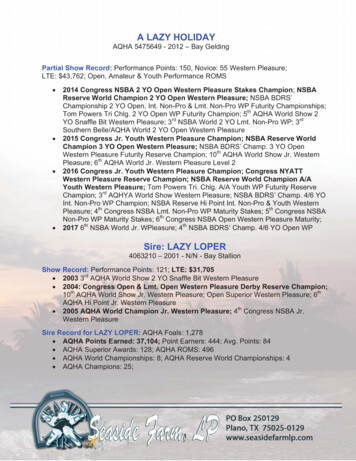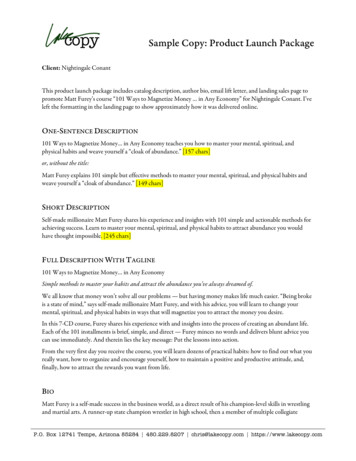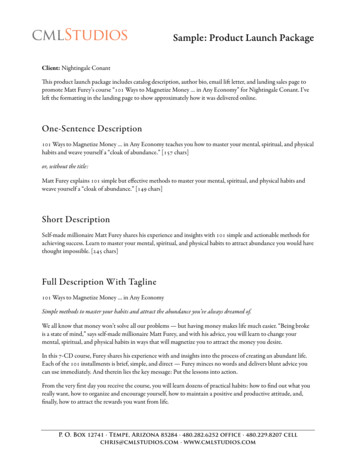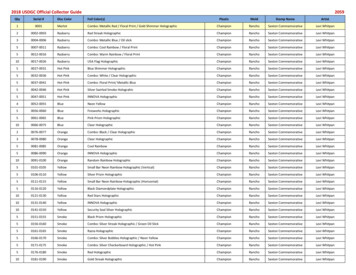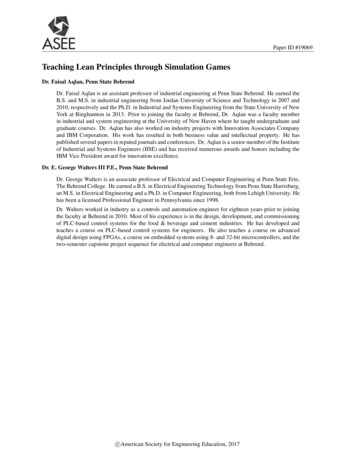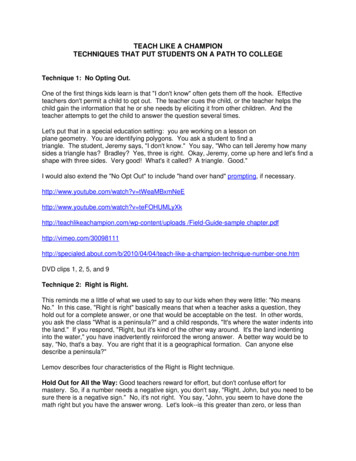
Transcription
TEACH LIKE A CHAMPIONTECHNIQUES THAT PUT STUDENTS ON A PATH TO COLLEGETechnique 1: No Opting Out.One of the first things kids learn is that "I don't know" often gets them off the hook. Effectiveteachers don't permit a child to opt out. The teacher cues the child, or the teacher helps thechild gain the information that he or she needs by eliciting it from other children. And theteacher attempts to get the child to answer the question several times.Let's put that in a special education setting: you are working on a lesson onplane geometry. You are identifying polygons. You ask a student to find atriangle. The student, Jeremy says, "I don't know." You say, "Who can tell Jeremy how manysides a triangle has? Bradley? Yes, three is right. Okay, Jeremy, come up here and let's find ashape with three sides. Very good! What's it called? A triangle. Good."I would also extend the "No Opt Out" to include "hand over hand" prompting, if necessary.http://www.youtube.com/watch?v tWeaMBxmNeEhttp://www.youtube.com/watch?v t/uploads /Field-Guide-sample chnique-number-one.htmDVD clips 1, 2, 5, and 9Technique 2: Right is Right.This reminds me a little of what we used to say to our kids when they were little: "No meansNo." In this case, "Right is right" basically means that when a teacher asks a question, theyhold out for a complete answer, or one that would be acceptable on the test. In other words,you ask the class "What is a peninsula?" and a child responds, "It's where the water indents intothe land." If you respond, "Right, but it's kind of the other way around. It's the land indentinginto the water," you have inadvertently reinforced the wrong answer. A better way would be tosay, "No, that's a bay. You are right that it is a geographical formation. Can anyone elsedescribe a peninsula?"Lemov describes four characteristics of the Right is Right technique.Hold Out for All the Way: Good teachers reward for effort, but don't confuse effort formastery. So, if a number needs a negative sign, you don't say, "Right, John, but you need to besure there is a negative sign." No, it's not right. You say, "John, you seem to have done themath right but you have the answer wrong. Let's look--is this greater than zero, or less than
zero? Less? Right! What do you need to make the answer correct? That's right, a negativesign."Answer the Question: Sometimes students know they can get you off the subject byintroducing something that is true, but doesn't actually answer the question. Say, you ask aquestion about setting and the student, who isn't quite sure what the setting is, answers "Thatreminds me of something that happened in our neighborhood." By relating it to the story, thestudent gets off the hook. A great teacher would respond, "That's really interesting, Juan, but Ineed you to tell me the setting of the story. What is setting? The place where it happens. So,where did the story happen?”Right Answer, Right Time: Some students who want to show that they already know how tosolve a math problem, may come up with a solution while you're still asking for one of thesteps. Back them up and have them just name the step you wanted. Teaching is not about theright answer. Teaching is about getting to the right answer.Use Technical Vocabulary: The answer for an addition problem is a sum. Be sure your studentknows that. Ask, "What is the sum?" and encourage students to say, "The sum is 14."Modification of Technique 2 for Special EducationShaping (accepting approximations successively till you get a complete response) would seemto rule out this technique. Not so. It is a reminder that special education teachers need to askquestions that students can answer successfully. If a child can't answer "Is the numbernegative or positive?" You need to have them come to the number line and tell you on whichside of the Zero on the number line the answer would fall. Then practice writing those numberswith a negative sign.So, plan ahead. Be sure you break the skills or information you are teaching into "chunks" withwhich your students can be successful.http://www.youtube.com/watch?v /teach-like-a-champion-technique-two.htmDVD clips 5-8Technique 3: Stretch It. The sequence of learning does not end with a right answer; rewardright answers with follow up questions that extend knowledge and test for reliability. Thistechnique is especially important for differentiating instruction. (TLC, p. 41)It's great when students get the answer right. It's better when they learn from it. If a child getsthe right answer a follow up question will verify that the student understands the answer, cementthat answer and extend knowledge. Here's a little model:Teacher: About how far is it from Philadelphia to Washington, D.C.?Juan: About 60 miles.
Teacher: Good Answer! How did you get it?Juan: I measured. An inch on the legend is 12 miles, and it is 5 inches from Philadelphia toWashington, D.C. I added 12 plus 12, plus 12, plus 12, plus 12 and got 60.Teacher: Would there have been a quicker way to find out it was 60?Juan: I could multiply 12 by 5.Teacher: Excellent! That would have been a much more efficient and quicker way to get thesame answer.This technique includes: Ask for how or why. The teacher asked "how."Ask for a better word. If Juan had said "That measurement thing," the teacher mightprompt for "legend."Ask students to integrate a related skill. You could ask Juan which direction he wouldtravel, which would require referencing the compass rose.Ask students to apply the same skill in a new setting: The teacher could ask Juan tocome up to the US map and use the yardstick to demonstrate to the class how to get thedistance from Washington D.C to Savannah, Georgia.This is a great technique for students in special education. The more we hammer home the skillor content we are teaching, the more likely it will be there tomorrow!http://www.youtube.com/watch?v /teach-like-a-champion-technique-three.htmDVD clip 21Technique 4: Format Matters. "The complete sentence is the battering ram that knocks downthe door to college."This has two components, correct grammar and complete sentence format.1. Correct grammar: even though you may accept that in some settings alternativelanguage, slang and popular usage may be appropriate, for school only the correctgrammar will work. You should: Identify the error. Offer the student an opportunity to self-correct. "We was walkingdown the street?"Begin the correction: "We were . . ."1. Complete sentence format: Provide students maximum experience creating sentenceson the spur of the moment.
Provide the words to start the sentence: "How many dogs are there?" "Six." "There are. . ." "There are six dogs."Provide a reminder in the question: "Who can tell me in a complete sentence how manydogs are left?"Provide a simple, direct prompt after the question: "How many dogs areleft?" "Six." "Complete sentence, please?"http://www.youtube.com/watch?v /teach-like-a-champion-technique-4.htmDVD clips 2, 4Technique 5: No ApologiesLemov notes that how we talk about expectations may automatically lower them. We mayapologize for content, or apologize for students.If you teach English, teach English. Don't apologize for teaching Shakespeare. I loveShakespeare! (I actually saw Kenneth Branagh in Henry V at the Barbizon in London, but I wasmostly impressed with the rain at the battle of Agincourt. Still that "We few, we happy few, weband of brothers;" is majorly cool.) But how many teachers have said, "I have to teach youShakespeare." But King Lear's daughters are such manipulative hussies (except for Cordelia,of course.) If you are dealing with students having difficulty with reading, it's one thing to modifythe text. It's another to diss the text. There are ways teachers apologize for content. Assuming something will be boring. "Guys, I know this is kind of dull . . .” Maybe youthink it's dull, but could you be wrong? Thousands and thousands of accountants lovecolumns of numbers.Blaming it. Pointing to the state curriculum ("The state says we have to teach this,") orthe head of the department ("Mrs. Johnson wants us to teach this.") leaves students thatthere is no real intrinsic value to the assignment.Make it "Accessible." Substituting rap for sonnets is not the same as using rap tointroduce alliteration and then examine Shelley. Some alternatives to apologizing:"This is really important, because it introduced some important characters.""A lot of adults find this challenging, so when you've mastered it, you'll be smarter than a lot ofadults!"Apologize for Students:The first program that Lemov started in an inner city community offered Mandarin as a foreignlanguage. Lot's of people said, "You can't teach these kids Mandarin." Even their parents said,"My kid won't sit still for that." But Lemov points out--millions and millions of people learnChinese, even very poor ones. They're ach-like-a-champion-technique-5.htm
DVD clip 10Technique 6: Begin with the end.Doug notes that too often teaching objectives are written with the activity in mind. Say, thecurriculum says, "teach King Lear," so the teacher writes a lesson plan that goes with King Lear.With technique 6, the teacher is thinking, "What do I want the students to know about King Learat the end of the class?" The teaching objective will drive toward that goal. So, what do skills doyou want the students to gain from King Lear? It might be a great time to talk about thedifference between comedy and tragedy. It might also be an opportunity to talk about characterdevelopment. By knowing the end result, the methods and strategies the teacher chooses willdrive toward those goals.Begin with the end will also mean that the teacher will: Refine and perfect the objective based on the previous day's success.Include a short assessment for the end of the class to see whether the objective wasmastered.Plan an activity or series of activities that lead to mastery of the objective.This should be a natural for special education teachers. We write goals for IEP's, and weshould always be thinking about what successful completion of those goals looks like. Thesame is true for technique 6: plan with the end in mind.http://www.youtube.com/watch?v zyw75NaZK e-a-champion-technique-6.htmTechnique 7: the 4M's.4 M's: Teaching objectives need to be: ManageableMeasurableMade FirstMost ImportantManageable: Lesson plan objectives need to be achievable during a single 50 or 60-minuteperiod. You may be teaching addition with regrouping, but you can't possibly expect a child tomaster regrouping in one lesson. So . . . Unmanageable: Students will add multi-digit numbers regrouping when a columnexceeds 10.Manageable: Students will add two digit numbers regrouping in the one's place.
Measurable: Build in an assessment. You might even want to use an "exit ticket" strategy,especially when you teach in a high school or middle school setting. In other words, for themanageable goal above, you would have your students complete a short, 10-problemassessment and hand it to you as they are leaving the room. In an elementary classroom itmight be traded in for a preferred activity.Made First: This is supported by Technique 6, Begin with the End. Teachers who decide whatthey are going to teach and then write the objective miss the boat. Sometimes what they post(technique 8, next week) is just a vague state standard. Write the objective, and then designthe lesson.Most important: The objective should focus on what is most important on the path to college,nothing else.For special educators, this particular goal may be less important for lesson planning than forgoal writing. Working in a residential program that pulls kids from 6 states and the metropolitandistricts of New York (bad) to Washington D.C. (abysmal) I have seen some pretty lamegoals. They're lame because they fail to meet the 4 weebly.comTechnique 8: Post it.Lots of school districts require that you post your objective for the day. Many, like Philadelphia,require that you use their objective straight from their "core curriculum." Useless, according toLemov.You post the objective so that the students, your peers and any supervisors know clearly whatyou expect your students are going to learn during the 45 to 60 minute period in which you areteaching. Hopefully you used Technique 7, the 4 M’s: ManageableMeasurableMade FirstMost ImportantObjectives written by the district are often not specific, and are written in such a general waythat they are far from manageable or measurable.When you post your objective, be sure to refer to it as you are teaching: "Today, you can seefrom our objective, we will be comparing the government of the United States with thegovernment of England. Everyone will be expected to write down 4 things that are similar and 4things that are different."
For significantly disabled students, either with autism or in a life skills program, you will probablybe creating objectives for each student, you probably want to carry your individual plans withyou, in a basket or as I do in a notebook that goes with me for "Table Time." That way I canreview my objective as I move from child to child to refocus. It is also available for mysupervisor.http://www.youtube.com/watch?v /teach-like-a-champion-technique-8.htmTechnique 9 -- the Shortest Path.We may be tempted by the allure of clever activities, clever lessons, or interesting approaches,but Lemov has found that the shortest distance between two points continues to be a line. Theactivity that most quickly gets you to the final point, the objective, is the best.Of course there are lots of ways to pace a 45-minute lesson, and lots of ways to reinforce alesson. Those things can be added and will be addressed later. The point of this technique isto get to the objective quickly and then hammer the lesson home with lots of practice,collaborative activities, drill, and other techniques that will guarantee that the objective is welllearned.http://www.youtube.com/watch?v /teach-like-a-champion-technique-9.htmTechnique 10: Double PlanYou might be tempted to think that this means plan twice as much as you need. But successfulteachers double plan.Most teachers focus on what they do as they are teaching. A lesson plan focuses on what theyare doing. But what are the students doing? What do you ask them to do to support their ownlearning? Fill in a graphic organizer? Take notes? What kind of notes.It's funny how many high school teachers will fret and fume that students don't take notes. Buthave they ever taught them? I was in "honors" English, science and history in high school, andmy English teacher my junior year taught us how to make an outline. It stuck with me for years,and I will sometimes still commit an outline to paper when I am writing (these articles are shortenough that I can project it in my mind.) But, if you want students to take notes, what will theylook like? Do you know if the students can make notes, or do you need to give them a format?To succeed at Technique, Lemov recommends that you make a T chart for your plans. At thetop you put the objective for the lesson. On the left you write what you, as the teacher, do. Onthe right side you write what the students do for each activity you put on the left. Do they fill in agraphic organizer? Do they make a list of important facts? Do they brainstorm with apartner? Do they create flash cards? There are all kinds of ways to support and reinforce a
lesson. Be sure that you have plans and materials to support your objective and collectinformation about their success.http://www.youtube.com/watch?v /teach-like-a-champion-technique-10.htmTechnique 11: Draw the MapDrawing the map is basically planning the environment. Or, more simply put, it is the seatingchart. Of course I wrote potentially longer, because the seating chart and the classroomenvironment, like everything else, needs to be evaluated constantly and changed whenneeded. Lemov notes that all too many teachers make a seating chart at the beginning of theyear and don't change it according to the changing needs of a class.When you draw the map, you need to ask some important questions: When should students interact in school?How should students interact in school?What should the way student's sit signal and incentivize about the various kinds ofinteractions?Which kinds of interactions support which kinds of lesson objectives?Clustering groups of four may be a popular way to encourage collaboration, but it alsoencourages talking and means that during whole group instruction, at least two people in eachgroup have to turn to face the teacher. Lemov does not recommend this set up. (Ironic,because we were told that was how our students should sit when I taught in Philadelphia.)Lemov's preferred formation is paired columns of rows: three paired columns, of six across, and4 to 5 rows. It makes it possible for the teacher to be able to move among students, and alwaysbe able to lean over and whisper in a student's ear. It means students will face the teacher inthe front of the room. Pairs also encourage two students to collaborate. For larger groups, theteacher may make another map and establish a routine to get into groups.Drawing the map also refers to what is on the walls. Lemov warns against too much orunimportant things on the walls. This is especially true for special education students, who areoften distracted by two much visual information. He also recommends student work, butsuggests that what is written on it is more specific than "Good," or "Outstanding." He suggeststhat teachers comments on work that is posted is specific to model what the teacher values asgood work--so the comments might be "Excellent use of adjectives to describe," or "Your neatwork on this paper helped you do an accurate job."http://www.youtube.com/watch?v /teach-like-a-champion-technique-11.htm
Technique 12 -- Hook it.The "hook" Doug speaks of is called the "anticipatory set" in educational circles, but "hook" is agood vernacular way of expressing "anticipatory set." It's the thing that grabs, or "hooks" yourattention and helps to focus you on the topic at hand. It could be a story, a puzzle, a picture, ora riddle that grabs your student's attention and then leads them into the topic at hand. Dougsuggests the following:1. A Story: Tell a quick and engaging story. If you're teaching the bill of rights, you mightwant to tell a story about a child who got sent to the office because of a shirt he waswearing. If you're introducing multiplication, you might tell about a caterer deciding howmany chicken fingers he needs to buy for a banquet to serve all the children in yourclass.2. Analogy: Find something in your students' lives that connects with the concept you areteaching. Maybe you're going to teach about the circulatory system and you brainstormwith your students how they might get a crate of oranges to all the people on a city blockby carrying 3 oranges in each backpack of the 25 children in your class.3. Prop: A good prop can quickly engage your students. Want to talk aboutspores? Nothing like a really green moldy piece of bread to get your student'sinterest. Talking about the 2nd world war? I still have my father's Army Air Forceuniform, which would certainly give kids a hands on experience of what people felt andexperienced as the United States joined with the allies to battle fascism.4. Media: A popular song or a brief piece of video might introduce your lesson. For somegreat little teaching videos, you might check Teacher Tube. This week they're featuringan actor doing a dramatic presentation of the Gettysburg Address. While I was aLutheran Pastor I lead a workshop for young church leaders (teens) on worship andused a scene from Mad Max: Beyond the Thunder Dome. It was a real hit, and quicklygot across the elements of worship.5. Status: With the furious energy that is focused on celebrities, status and fame capturethe attention of many students. You might want to ask your students if they heard aboutLindsey Lohan going to jail--and you might connect her to someone like Nelson Mandela(if your are talking about apartheid or slavery or some other injustice.) When introducinga topic, talk about how it is "great." "The book we are reading was on the best seller listfor 36 months." Or, "This author is considered the greatest of the beat generation."6. Challenge: Give the students a task, individually or in small groups. Back to introducingmultiplication: "There are 24 children in our class. If I buy jelly beans for the whole class,and everyone will get 8 jelly beans, how many jelly beans must I buy? The three peoplein your group see if you can figure it out, and be prepared to report out how you got yourresult." If you're teaching Shakespeare, you might challenge the class to translate aspeech from your reading for the day into modern English (You might show a clip ofLeonardo DiCaprio in Romeo and Juliet to talk about updating Shakespeare's dialog.)For a hook to be truly successful it needs to live up to three criteria:1. It's short. It's the introduction, not the lesson.2. It yields. It will quickly get you to instruction, not down a side alley. Something that isclever but doesn't actually serve the lesson will only waste your time.
3. It's energetic and optimistic. You dwell on what is great about Shakespeare, ormultiplication or the bill of rights, not what is hard, or confusing or difficult, unless that iswhat makes it great.A final note: You don't need a hook for every lesson. Some teachers use hooks only tointroduce new material.http://www.youtube.com/watch?v /teach-like-a- champion-technique-12.htmTechnique 13 - Name the Steps.Lemov notes that few gifted athletes make good coaches. What they learn naturally does notcome easily to the typical athlete, and they never have to break tasks down into discrete steps-they see the whole. In fact, an important skill for children with more severe disabilities that forcertain tasks, a "task analysis" is required.Lemov wisely points out that as teachers we need to keep in mind the difference between a"Champion Performer" and a "Champion Teacher." A champion performer is good at a task; achampion teacher helps someone else succeed at that task.There are four key components of Name the Steps: Identify the steps: Be sure that the steps are clear and follow in logical order. Be surethere are not too many, or it will overwhelm your students and make it difficult for them tosucceed.Make them stick. First name the steps so they will be easy to remember. Then find away to make them "stick" through a mnemonic or a story. One example was a teacherwho taught the steps of finding the meaning of new words. She found three steps:1. Context - use the words around it (the context) to find the meaning.2. Apposition--look for words in apposition, which help rename the word. (i.e. Sheadjusted her tiara, the small crown of diamond-encrusted gold.)3. Relational Words: check for but (the word means the opposite) and or also(means the same thing.)The teacher made the acronym CAR from the steps, and made frequent reference to "Drivingthe CAR." Build the steps. You can use the process of discovering the steps to build the steps. Astrong and memorable lesson would be one where the students are challenged todiscover the rules themselves.Use Two Stairways. There are often two parallel stairways rising in your class: thesteps for solving the particular problem you are dealing with. The second staircaseconsists of the steps that rise to solving all problems of the same kind.
Take as an example regrouping for addition.Teacher: "John, add the numbers in the ones column. What do you get? "John: "8 plus 5 is thirteen."Teacher: "Excellent. Mark, what do we write here, under the 5?"Mark: "A three. You put the one over the 8 because it goes in the tens place."Teacher: "Excellent. I see you anticipated my next /teach-like-a-champion-technique-13.htmTechnique: 14 Board Paper.This particular technique requires preparation, at least the first time you teach material. A namecommonly used for this technique in special education is "graphic organizers," with thisparticular organizer referred to as "guided notes." It is a great way to teach note taking and helpall students, both special education and typically developing students, learn to look and listen forcues as to what is important in a lesson or a textbook passage.The teacher prepares an outline for the day’s lesson with the things he/she wants the children tolearn. The teacher then prepares a mock up of the same outline, with lots of blanks. Start outwith only a few missing words and circulate as you teach to be sure the children are filling itin: you may also want to put the whole outline with the missing words on a Smart board or on atransparency with an overhead. The trick is to increase the number of spaces, to the point thatthere is just a bare outline, and students listen for what needs to go next to a, b, and c.The guided notes are also a good place to differentiate instruction: you won't be able towithdraw the support for note taking as quickly as you can for typically developing children, butthe notes can be part of the special education students test preparation. A "study guide" basedon the guided notes (the student searches his or her own guided notes for the answers) is agood way to help students with specific learning disabilities prepare for tests. Be sure that thestudent, not an educational aide, fills in the guided notes: this is one place where aneducational aide will get frustrated with a student's slow pace and will over function for -like-a-champions.htmTechnique 15 -- Circulate.
The seating plan you choose not only should fit your main teaching strategy, but should alsopermit you, as the teacher, to circulate, moving around the room in order to supportinstruction. Doug offers lots of different parts of the strategy: Break the Plane: The "plane" is an imaginary line parallel to the front board, just aboutwhere the first row of desks begins. In order to assert control over the whole room, thatimaginary line needs to be broken early and often.Full Access Required: You must have access to every corner of the room. Theteacher needs to be able to stand naturally next to any student in the room at any timewithout interrupting your teaching. You don't want students to create a "No Fly" zonewith backpacks, so you need to be sure students know that backpacks need to be undertheir seat, not on the side or on the aisle.Engage When You Circulate: Teach as you move around the room and make constantverbal and non-verbal interventions as you go: "Laurisa, I think I asked you to have yourbook on your desk," or tapping someone on their shoulder, to remind them to get outtheir book.Move Systematically: Look for opportunities to move systematically: universally,impersonally but also unpredictably. It creates an environment where students knowyou may stand next to them any moment, and make them accountable. Making abeeline to the most difficult student gives the message to that student that you know he(or she) is a challenge. Moving systematically means that you can show up at thatstudent’s desk without making your anxiety visible.Position for Power: Face as many students as possible. The most powerful position iswhere you can see a student, the student knows you can see him, but he cannot seeyou.The Seating Plans for Whole Group Instruction creates the best opportunities for putting thistechnique in place. Still, it is possible to circulate in other formats. Be sure if you have anychildren with hearing problems--they will need to see your mouth in order to hear what you like-a-champions.htmDVD clips 3, 9, 10, 11, 12, and 21Technique 16: Break It DownLemov clearly sees that the instructional moment is imbedded in the regular instructionalpractice of asking and answering questions. He also clearly sees that a wrong answer mayactually be a more powerful tool for teaching than a right answer. That's where "breaking itdown" comes into practice.In "Break It Down," rather than immediately moving on to the next student, the teacher redirectsin an attempt to help the student find the answer. It can be as simple as giving a single clue (Ioften prompt my boys with Autism with the first letter of a word: "S" "summer!" "That's right, it'ssummer!") Lemov suggests you attempt successive strategies:
1. Provide an example. Say you ask for a student to name a prime number and are metwith a blank stare. Try "7 is prime, and so is 11."2. Provide context. In a reading selection you come upon a new word that will be part of avocabulary exercise. "The council clearly found Martin's failure egregious." You couldsuggest "I would find it really egregious if you stole my chocolate pudding." Students
mastery. So, if a number needs a negative sign, you don't say, "Right, John, but you need to be sure there is a negative sign." No, it's not right. You say, "John, you seem to have done the math right but you have the answer w

